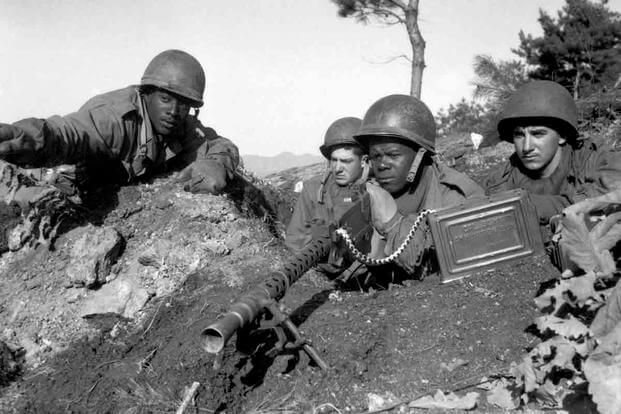Bob Marley first sang about Buffalo Soldiers in 1983, a little less than 120 years after the actual Buffalo Soldiers were formed in the U.S. Army. Marley's song accurately depicts their story as a fight for survival in the prejudiced Army of the time period, but they also fought to survive the harsh conditions of the frontier, conflict with native tribes and Wild West outlaws as they sought to maintain law and order and protect settlers.
The Army units that would come to be known as "Buffalo Soldiers" were created during the post-Civil War Reconstruction Era. On June 28, 1866, Congress passed a legislation that allowed Black men to enlist in the peacetime army. Officially called "An Act to Increase and Fix the Military Peace Establishment of the United States," it created two regiments of all-Black cavalry and four regiments of all-Black infantry, commanded by white officers.

What Is a Buffalo Soldier?
The original Buffalo Soldiers came from these units. The U.S. Army's 9th and 10th Cavalry were the first. Then came the four infantry units. The 38th U.S. (Colored) Infantry Regiment and the 41st U.S. (Colored) Infantry Regiment, were eventually consolidated into the 24th Infantry Regiment. The 39th and 40th (Colored) Infantry Regiments were consolidated into the 25th Infantry Regiment.
They weren't the first Black men to serve in defense of the United States. Black men served in the Continental Army and state militias during the Revolutionary War. Black troops served in the War of 1812, and freedmen and former slaves fought in the Civil War for the Union Army. The 1866 legislation was the first to call for specific units composed of Black troops and recruited from Washington, Louisiana, Kentucky, Kansas and Missouri.
Buffalo Soldiers' Service History
After its formation in New Orleans, the 39th Infantry remained in Louisiana to enforce Reconstruction laws. The 40th was sent to North Carolina for the same occupation duty, before being sent to New Orleans to form the 25th Infantry. The 41st was sent to the U.S. border with Mexico before it was merged to form the 24th Infantry to enforce laws on the Texas frontier.
As the frontier moved west, the 24th was at the vanguard, manning forts and outposts, fighting native tribes in the Plains Wars, which would continue long after the frontier was officially closed in 1890. The 24th Infantry would be the longest-serving infantry unit in the Army.
It fought in the Spanish-American War, notably the Battle of San Juan Hill with future President Theodore Roosevelt's Rough Riders.

They also served in the Philippine Insurrection, the Mexican Border clashes and World Wars I and II. It was the last Buffalo Soldier regiment to be integrated, which came when President Harry S. Truman desegregated the armed forces before the Korean War.
The 25th Infantry also fought native tribes on the Great Plains, in the Spanish-American War, the Philippines and in World War II.The 9th and 10th Cavalry would also participate in these same American conflicts, but the 10th Cavalry Regiment would also ship off to the Mexican border during World War I, where it would clash with a Mexican force led by German advisers in a border skirmish now known as the Battle of Ambos Nogales.
Origin of the "Buffalo Soldiers" Nickname
These soldiers weren't created with the name "Buffalo Soldiers." It was a moniker the units picked up along the way. No one is entirely certain about the origin of the name, but there are two main theories.
The first is that the name was bestowed on the men by Comanche fighters. After fighting the 10th Cavalry in 1871, the theory goes, the Comanches began referring to the Black men as "Buffalo soldiers." It wasn't meant derisively, as the Comanches revered the buffalo and gave the soldiers the name Buffalo for their toughness in combat.

Another theory holds that the tribes the Black men encountered believed the soldiers' dark, black, curly hair resembled the hair of the buffalo's. This, too, was meant as a sign of respect, and the cavalrymen adopted the buffalo on their coat of arms as well as the nickname.
Famous Buffalo Soldiers
In 1866, an enlistee by the name of William Cathay joined the 38th Infantry for a three-year term. After a series of illnesses sent Cathay to the hospital, it was discovered that Cathay was actually Cathay Williams, a Black woman. She was honorably discharged after the discovery, but was still the first official Black woman to enlist, and the only female Buffalo Soldier.
Read: Cathay Williams Was the Army's Only Female Buffalo Soldier and First Black Female Enlistee
Between 1866 and 1918, 27 members of the regiments of Buffalo Soldiers would receive the Medal of Honor for actions in the Plains Wars, law enforcement on the American frontier, the Spanish-American War and World War I. The first three Black graduates of the U.S. Military Academy at West Point were officers with the Buffalo Soldiers. Charles Young, the third graduate, would become the first Black man with the rank of colonel.
Mark Matthews was the last living Buffalo Soldier. He enlisted at age 15 in 1909, joined the Punitive Expedition in Mexico and fought at the Battle of Ambos Nogales. In World War II, Matthews fought at the Battle of Saipan at age 50. He died in 2005, at 111 years old.
-- Blake Stilwell can be reached at blake.stilwell@military.com. He can also be found on Twitter @blakestilwell or on Facebook.
Want to Learn More About Military Life?
Whether you're thinking of joining the military, looking for post-military careers or keeping up with military life and benefits, Military.com has you covered. Subscribe to Military.com to have military news, updates and resources delivered directly to your inbox.














